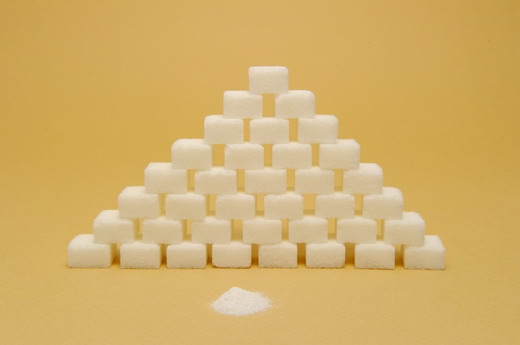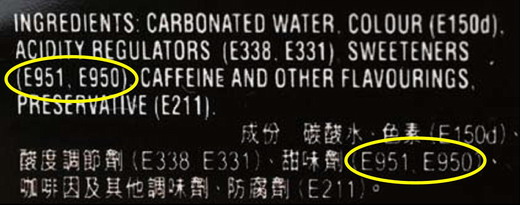
Food Safety Focus (44th Issue, March 2010) – Food Safety Platform
Sugar Substitutes - Sweeteners
Reported by Ms. Janny MA, Scientific Officer,
Risk Assessment Section, Centre for Food Safety
Sugar is an ingredient that we love and hate. We love it as it provides sweetness to our food. We hate it as getting too much sugar may lead to excessive energy intake, increasing the risk of overweight and obesity. In order to eat less sugar but still enjoy sweet tasting food, some are going for the " sugar free " or " no sugar " options. Taking a closer look at the ingredient list of these products, you may find that sweeteners instead of sugar are being used. From this issue, we will move to a new series and savour these sweet tasting sugar substitutes – sweeteners.
What are Sweeteners?
Sweeteners are food additives, other than sugars, which impart a sweet taste to a food. Many of us may consider that all sweeteners are artificial chemicals; however, some are in fact naturally occurring plant extracts. Under local law, sweetener means any chemical compound which is sweet to the taste, but does not include any sugars or other carbohydrates or polyhydric alcohols i.e. sugar alcohols.
You may wonder why a tiny sachet of commercial table-top sweetener (about one gram) can provide sweetness equivalent to about two teaspoons of sugar (one teaspoon of sugar weighs about five grams). It is because, in general, sweeteners have intense sweetness, usually tens to thousands times sweeter than table sugar (Table 1). They can thus be used at a much lower concentration to provide sweetness in foods. You may even not know that commercial table-top sweeteners seldom contain pure sweeteners and may contain other ingredients e.g. lactose and dextrose as fillers. Sweetener itself may only contribute to less than 10 percent by weight. Moreover, these fillers may provide traces of energy and sweet taste to the product.
Table 1. Relative sweetness of some sweeteners
| Name of sweetener (INS* No.) |
Approximate sweetness (Relative to table sugar = 1) |
|---|---|
| Acesulfame potassium (950) | 200 |
| Alitame (956) | 2000 |
| Aspartame (951) | 180 |
| Cyclamate (952) | 30 |
| Saccharin (954) | 300 |
| Sucralose (955) | 600 |
| Thaumatin (957) | 2000-3000 |
* International Numbering System for Food Additives

1 g of aspartame is as sweet as 180g of table sugar
What makes sweeteners even more powerful is the extra sweetness enhancement property when certain sweeteners are mixed together. For instance, by mixing aspartame and acesulfame potassium at 2:1 ratio, the resulting sweetness is no longer some 180 but about 350 times greater than table sugar! It is therefore common to use more than one type of sweeteners in a food product.
In addition, sweeteners do not contain much energy nor affect insulin or glucose levels. They may assist in weight management and provide sweet tasting foods for people with diabetes.
Applications of Sweeteners
Sweeteners have been used to replace sugars in a wide range of products such as soft drinks, preserved fruits, confectioneries and chewing gums. Many sweet tasting products marketed as " sugar free " or " no sugar " may contain sweeteners. You can always check if sweeteners are present in a prepackaged food by looking at the ingredient list. The functional class i.e. sweetener together with its specific name or identification number have to be labelled if any of the sweeteners are used in the product.

The ingredient list of a beverage containing a spartame (951) and acesulfame potassium (950)
However, sweeteners cannot always simply replace sugar in food production as sugar may also perform other functions e.g. contribute to the texture of the products. Some sweeteners may also not be suitable for use under high temperatures e.g. for baking.
Safety of Sweeteners
Like other food additives, sweeteners have been thoroughly assessed for safety by international authority i.e. the Joint FAO/WHO Expert Committee on Food Additives (JECFA) before approved for use. The CFS has also conducted risk assessment studies to ensure the normal consumption of foods containing sweeteners would not pose any adverse health effects to the general population.
The cancer-causing concern of sweeteners has once arisen when early studies revealed that cyclamate and saccharin caused bladder cancer in experimental animals. However, subsequent studies indicated that there is no clear evidence demonstrating the association between sweeteners and cancer in humans.
Nevertheless, it is noted that a very small proportion of the population may experience adverse effects due to the consumption of specific permitted sweetener i.e. aspartame. Patients suffered from an inherited disease phenylketonuria (PKU) are advised not to consume aspartame because they are unable to metabolise the amino acid phenylalanine effectively, leading to the accumulation of potentially harmful levels and can cause serious brain damage. People who are sensitive to particular sweeteners are advised to check the ingredient list to identify their presence and avoid them.
In the coming issues, we are going to talk about two relatively new sweeteners, neotame and steviol glycosides.


